While many assume houseplants must feature simple, green leaves to thrive indoors, nature’s most spectacular foliage patterns actually flourish within your four walls. You’ll find leaves that spiral like pinwheels, sparkle with metallic sheen, and even mimic animal prints. From the Rex Begonia’s swirling royal purple to the Rattlesnake Plant’s reptilian patterns, these botanical oddities don’t just survive – they make bold statements. Let’s explore these living works of art that break every rule about what leaves “should” look like.
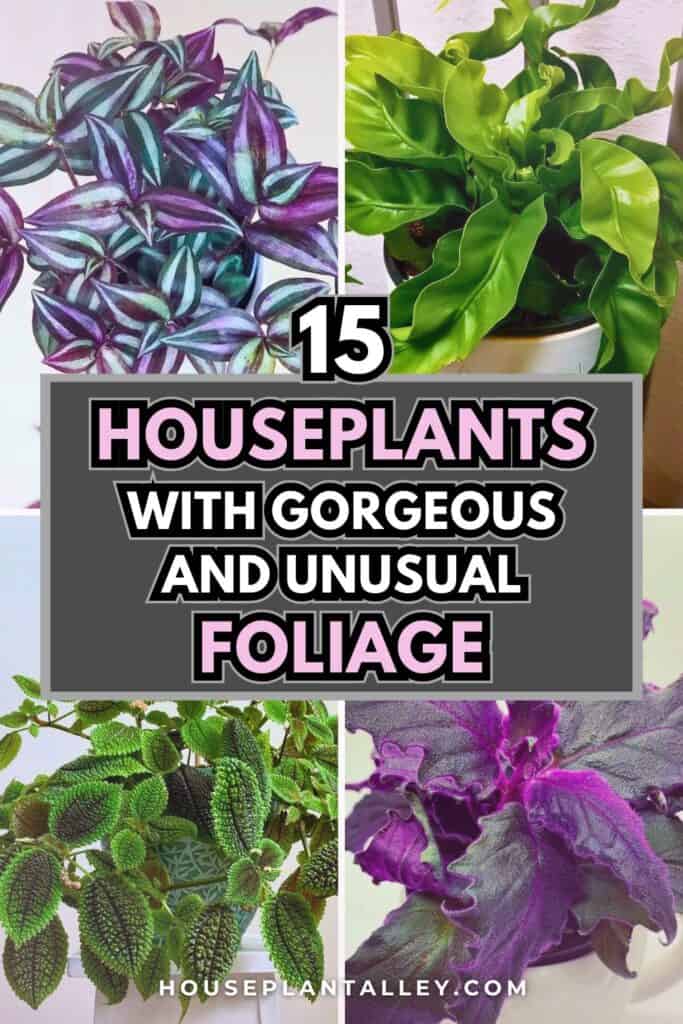
Contents
- 1 1. Rex Begonia
- 2 2. Chinese Evergreen
- 3 3. Polka Dot Plant
- 4 4. Snake Plant
- 5 5. Croton
- 6 6. Prayer Plant
- 7 7. Swiss Cheese Plant
- 8 8. Purple Shamrock
- 9 9. Living Stones
- 10 10. Moon Valley Pilea
- 11 11. Rattlesnake Plant
- 12 12. String of Pearls
- 13 13. Watermelon Peperomia
- 14 14. Peacock Plant
- 15 15. Pink Pitcher Plant
1. Rex Begonia
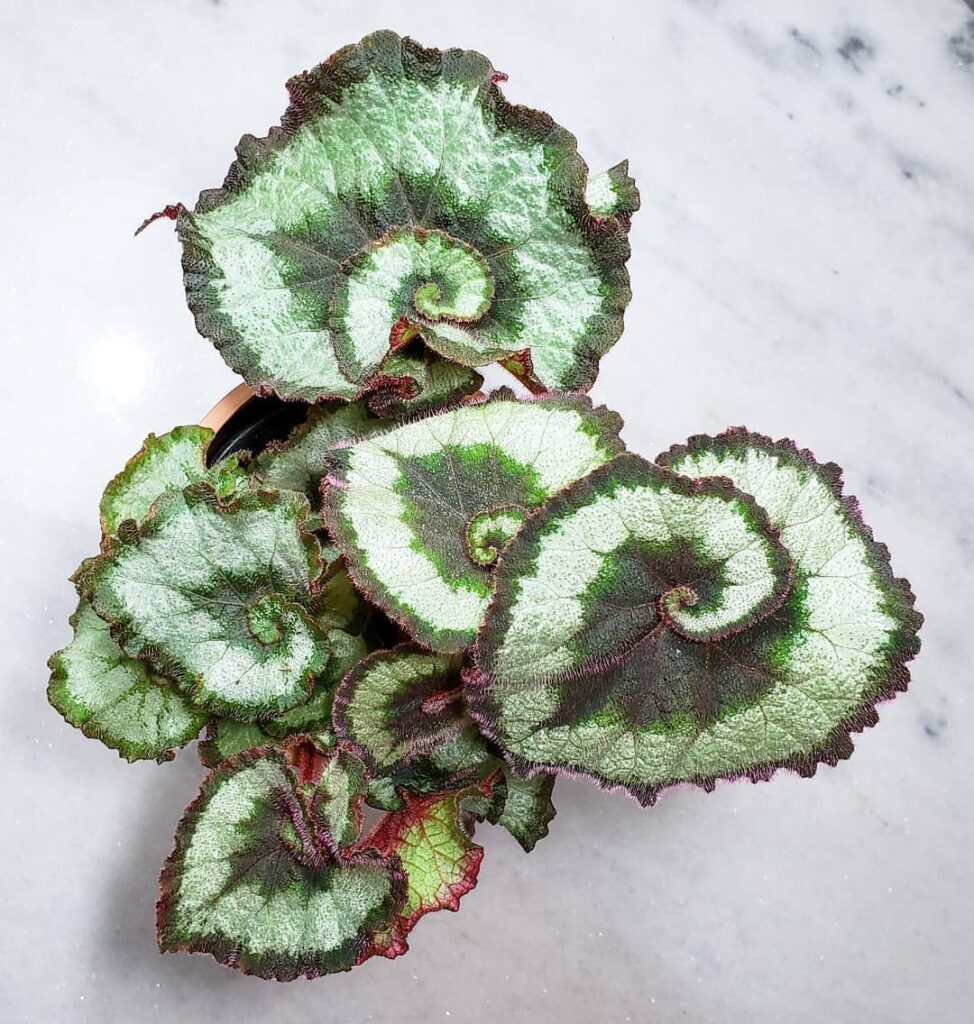
Rex Begonias are prized for their stunning foliage featuring dynamic swirling patterns in shades of silver, purple, red, and green. Their large, asymmetrical leaves showcase intricate spirals, pinwheels, and other mesmerizing designs that appear painted on the surface. These ornamental plants can grow up to 2 feet tall and wide, with each leaf displaying unique variations in color and pattern, making them a dramatic focal point in indoor plant collections.
- Light: Bright, indirect light; avoid direct sunlight
- Water: Keep soil consistently moist but not waterlogged; water when top inch of soil feels dry
- Humidity: High humidity (50% or higher); use pebble trays or humidifiers
- Temperature: 60-75°F (15-24°C)
- Soil: Well-draining, rich potting mix with high organic matter
- Fertilizer: Feed monthly during growing season with balanced liquid fertilizer
- Container: Use pots with drainage holes to prevent root rot
2. Chinese Evergreen
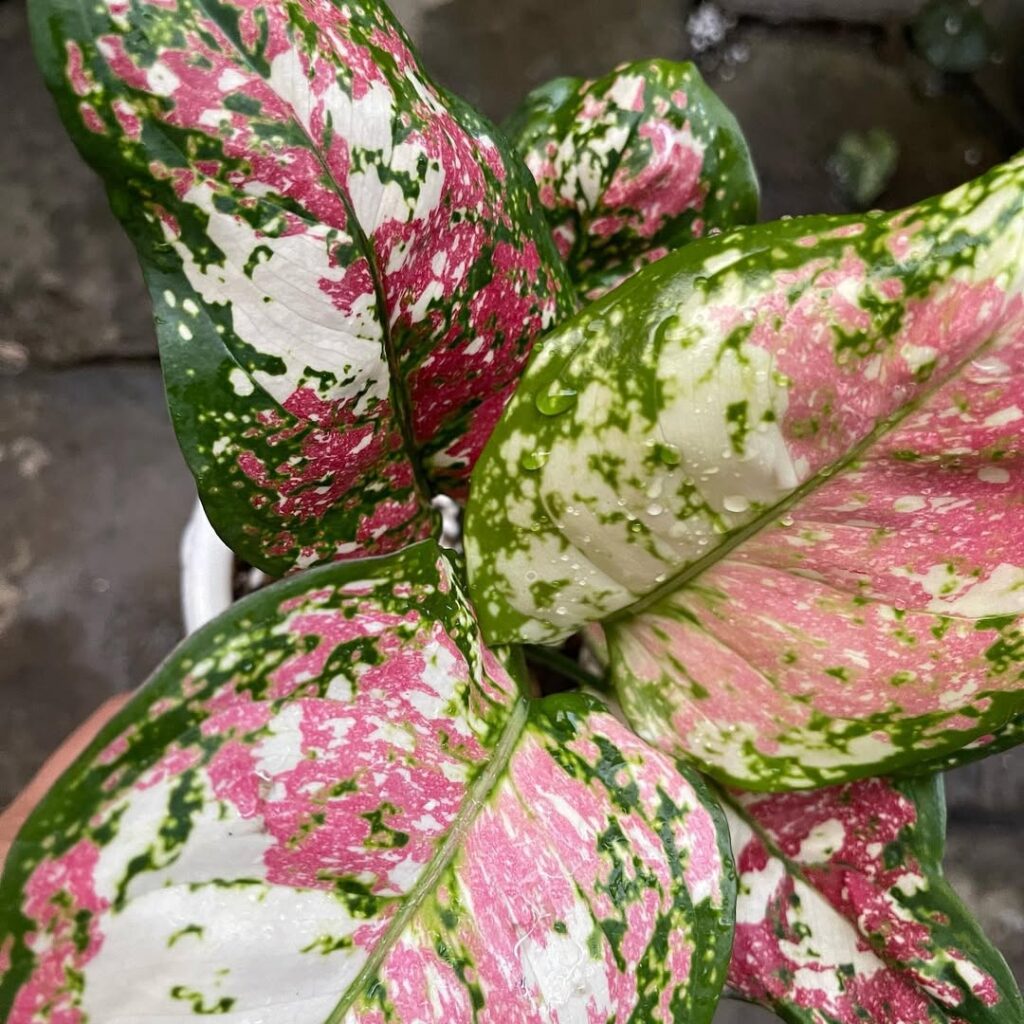
Chinese Evergreen (Aglaonema) features striking speckled foliage with patterns that range from silver specks to bold spots scattered across its oval-shaped leaves. The variegation creates a painterly effect, with some varieties displaying dark green leaves decorated with white or silver speckles, while others show pink, red, or cream-colored mottling. These distinctive markings make the Chinese Evergreen a standout choice for adding visual interest to indoor spaces through its foliage alone.
- Light: Thrives in low to medium indirect light; avoid direct sunlight which can fade the speckled patterns
- Water: Keep soil consistently moist but not waterlogged; water when top 1-2 inches of soil feels dry
- Soil: Well-draining potting mix rich in organic matter
- Humidity: Prefers moderate to high humidity; mist leaves regularly
- Temperature: Maintains best growth between 65-80°F (18-27°C)
- Fertilizer: Feed monthly with balanced liquid fertilizer during growing season
- Soil pH: Slightly acidic to neutral (6.0-7.0)
3. Polka Dot Plant

The polka dot plant (Hypoestera phyllostachya) features distinctive pink spots scattered across its leaves, creating a speckled or freckled appearance that makes it a striking houseplant. These spots can vary in size and intensity, with some varieties displaying bright fuchsia markings while others show softer, more subtle pink patterns against the green leaf background. The spots tend to be more vibrant when the plant receives proper lighting conditions, though too much direct sunlight can cause the colors to fade.
- Light: Bright, indirect light; morning sun is acceptable, but protect from harsh afternoon rays
- Water: Keep soil consistently moist but not waterlogged; water when top inch of soil feels dry
- Soil: Well-draining, rich potting mix with added peat moss
- Humidity: Prefers high humidity; mist regularly or use a humidity tray
- Temperature: 65-80°F (18-27°C)
- Fertilizer: Feed monthly during growing season with balanced liquid fertilizer
- Pruning: Pinch back regularly to maintain bushiness and prevent legginess
4. Snake Plant
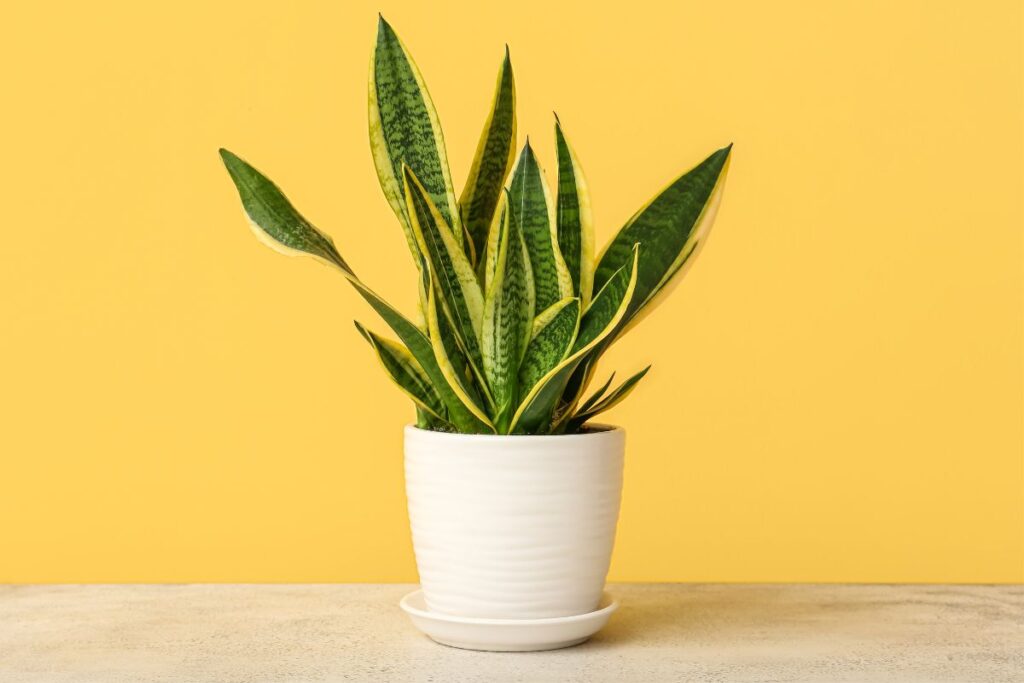
Snake plants (Sansevieria) feature tall, rigid leaves that grow vertically like a cluster of pointed daggers. Their distinctive sword-shaped foliage displays striking patterns of green and yellow stripes that zigzag horizontally across each leaf’s surface. These architectural leaves can grow anywhere from 6 inches to several feet tall, depending on the variety, creating a bold structural element in any indoor space.
- Light: Tolerates low light but thrives in bright indirect light; can handle some direct sun
- Water: Allow soil to dry completely between waterings; water less in winter
- Soil: Well-draining potting mix; preferably succulent or cactus soil
- Humidity: Adapts to average indoor humidity levels
- Temperature: Prefers 70-90°F; tolerates down to 50°F
- Fertilizer: Light feeding with balanced fertilizer during growing season
- Soil pH: 6.0-7.5
- Pot Requirements: Container with drainage holes; can be somewhat root-bound
5. Croton
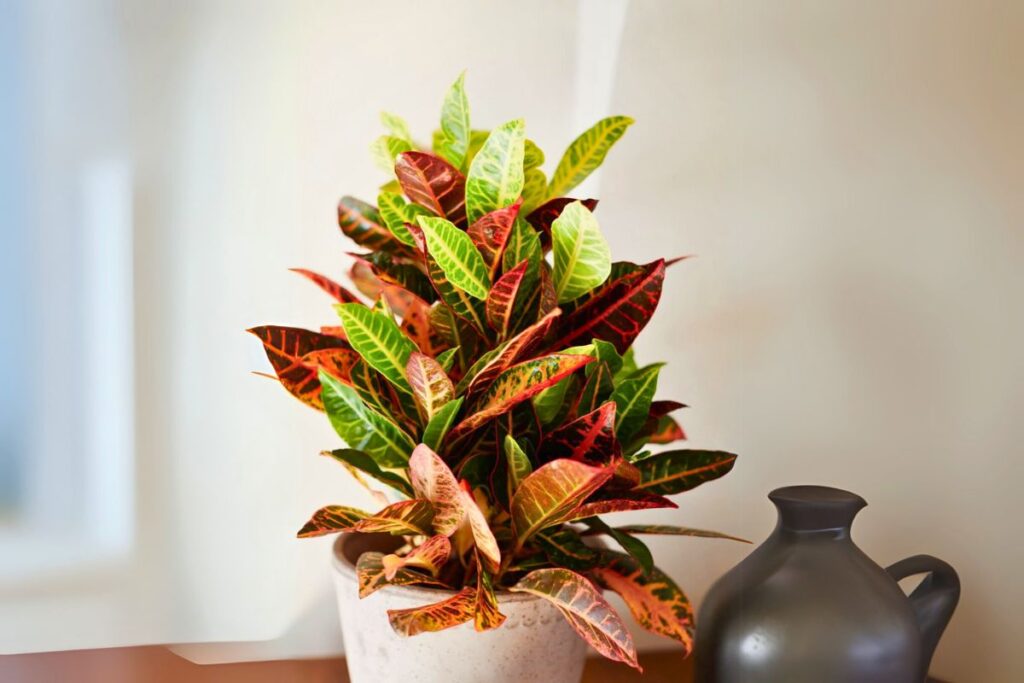
Croton plants (Codiaeum variegatum) showcase dramatic foliage with vibrant splashes of yellow, orange, red, and green that create a natural rainbow effect on their leaves. The bold patterns and colors intensify when the plant receives proper light exposure, making each leaf appear hand-painted by nature. These tropical showstoppers come in various leaf shapes, from broad and flat to thin and twisted, with their striking variegation patterns changing as the plant matures.
- Light: Bright, indirect sunlight; some direct morning sun acceptable; more light typically means more vivid colors
- Water: Keep soil consistently moist but not waterlogged; water when top inch of soil feels dry
- Humidity: High humidity (50% or higher); regular misting or use of humidity tray recommended
- Temperature: 60-80°F (15-27°C); protect from cold drafts
- Soil: Well-draining, rich potting mix with high organic matter content
- Fertilizer: Feed monthly during growing season with balanced liquid fertilizer
- pH Level: 4.5-6.5 (slightly acidic)
6. Prayer Plant
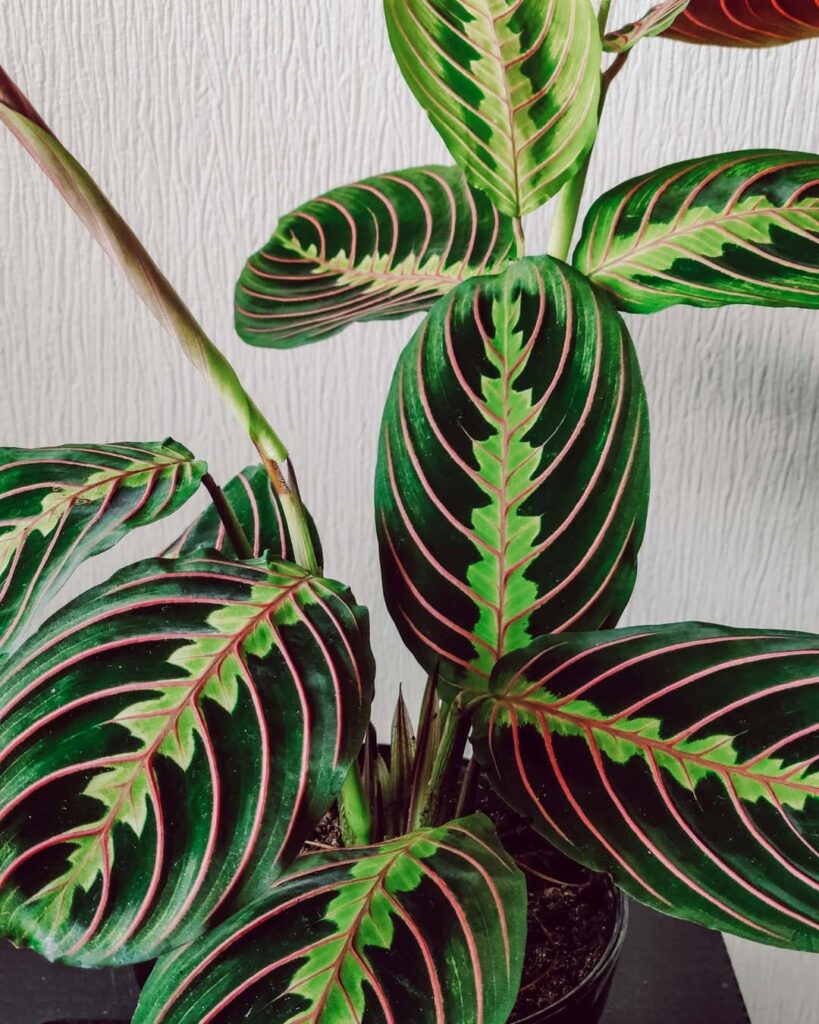
Prayer plants (Maranta leuconeura) are known for their fascinating nyctinastic movements, where their decorative leaves fold upward at night like praying hands and lower again during the day. This daily ritual, controlled by a joint-like structure at the base of each leaf, helps the plant protect itself and regulate moisture. The folding behavior is most pronounced at dusk and dawn, making these plants particularly intriguing specimens for indoor observation.
- Light: Bright indirect light; avoid direct sunlight which can fade leaf patterns
- Water: Keep soil consistently moist but not waterlogged; water when top inch of soil feels dry
- Humidity: High humidity (50-60%); mist regularly or use a humidity tray
- Soil: Well-draining, rich potting mix with organic matter
- Temperature: 65-80°F (18-27°C)
- Fertilizer: Monthly feeding during growing season with balanced liquid fertilizer
- Container: Pot with drainage holes to prevent root rot
7. Swiss Cheese Plant
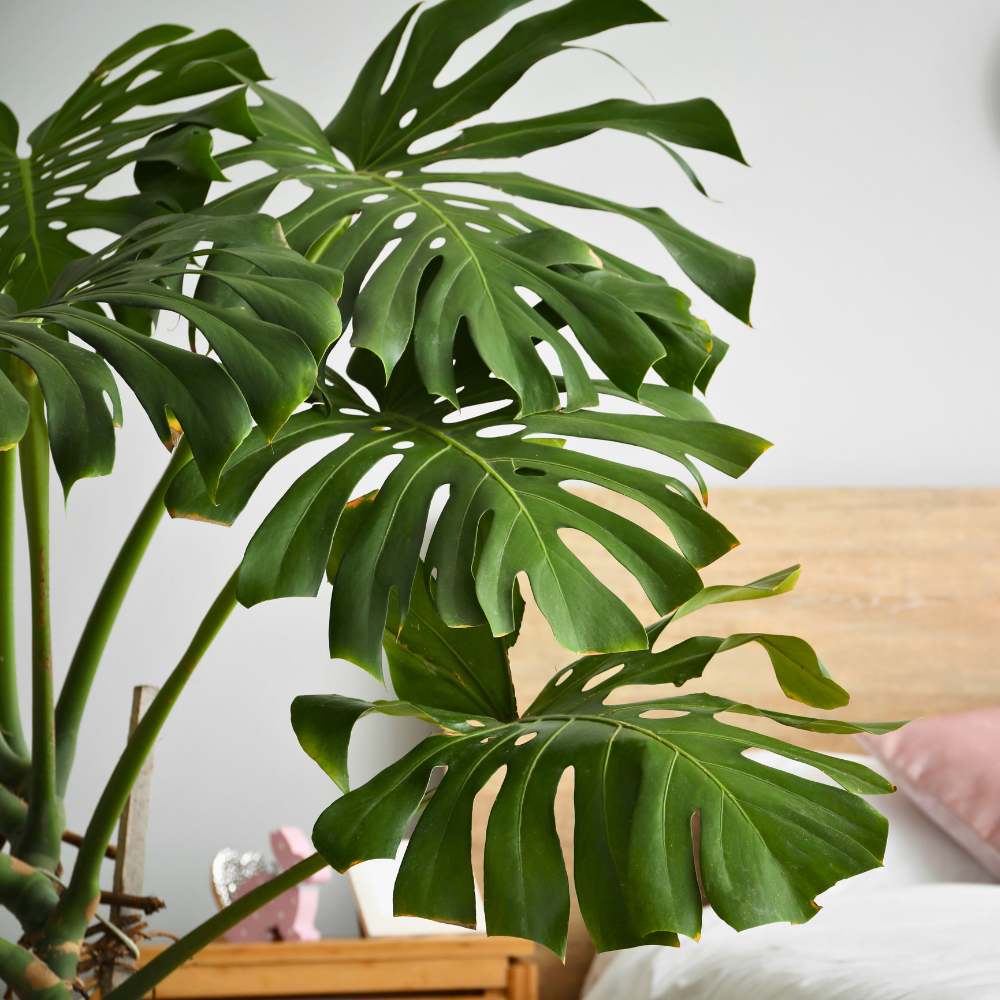
The distinctive holes and splits in Monstera deliciosa‘s leaves, known as fenestrations, develop as the plant matures and give it its common name “Swiss Cheese Plant.” These natural perforations are an evolutionary adaptation that allows the leaves to withstand strong winds in their native tropical habitat while also permitting light to reach the lower leaves. Young leaves start whole and develop their characteristic holes and splits as they grow larger, with more mature plants displaying increasingly dramatic leaf patterns.
- Light: Bright, indirect sunlight; avoid direct sun which can burn leaves
- Water: Keep soil consistently moist but not waterlogged; water when top 1-2 inches of soil feels dry
- Soil: Well-draining, rich potting mix with organic matter
- Humidity: High humidity (60% or higher)
- Temperature: 65-85°F (18-29°C)
- Fertilizer: Monthly feeding during growing season with balanced houseplant fertilizer
- Support: Climbing pole or trellis for aerial roots to attach
8. Purple Shamrock
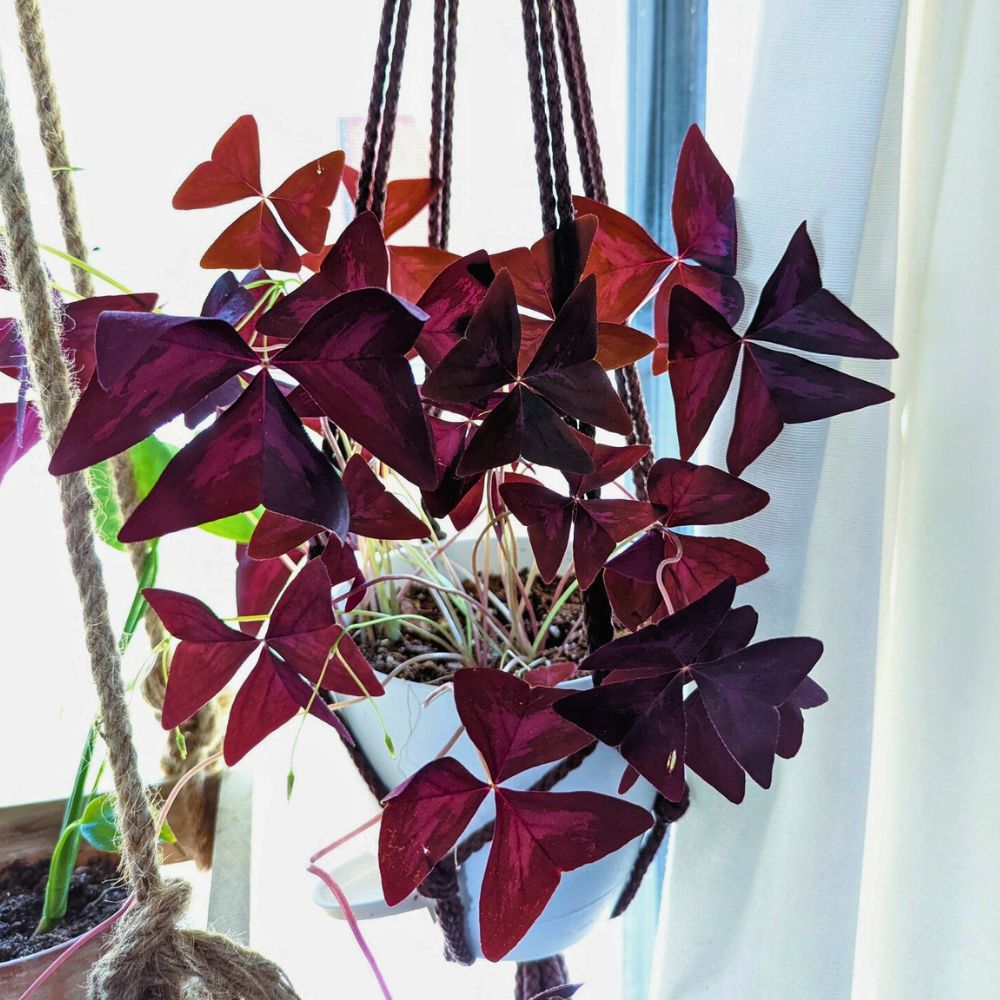
The Purple Shamrock (Oxalis triangularis) showcases distinctive triangular leaves that fold like butterfly wings in response to light and darkness. Each leaf consists of three deep purple leaflets that close up at night and during low-light conditions, then reopen when exposed to daylight. This nyctinastic movement, combined with the plant’s rich burgundy-purple coloring, makes it an enchanting addition to indoor spaces.
- Light: Bright, indirect sunlight; can tolerate some direct morning sun
- Water: Keep soil consistently moist but not waterlogged; allow top inch to dry between waterings
- Soil: Well-draining potting mix rich in organic matter
- Temperature: 60-75°F (15-24°C)
- Humidity: Average household humidity levels are sufficient
- Fertilizer: Feed monthly with balanced liquid fertilizer during growing season
- Container: Pot with drainage holes to prevent root rot
9. Living Stones
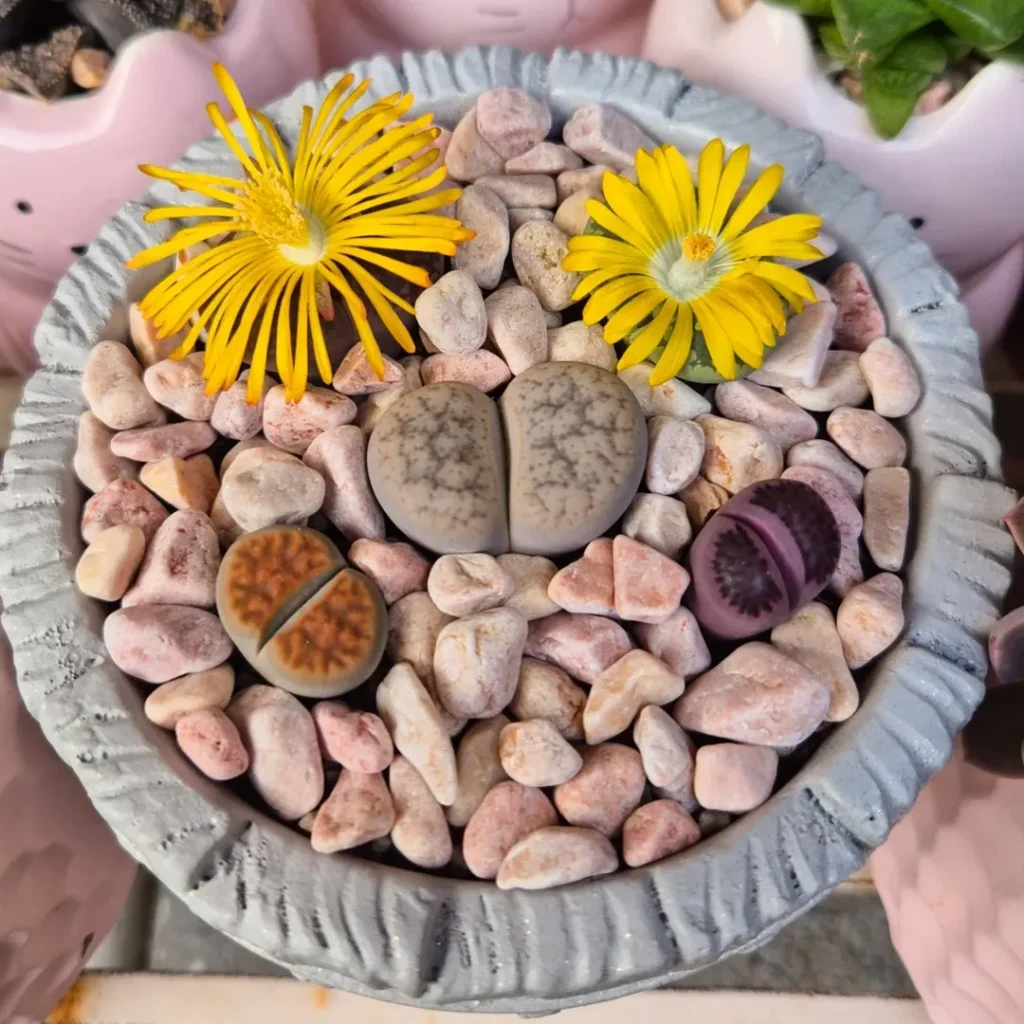
Living Stones (Lithops) are remarkable succulents that have evolved to perfectly mimic the appearance of small pebbles or stones, with just two thick, fleshy leaves that form a cleft where new growth emerges. These leaves are often speckled, textured, or marked in ways that help them blend seamlessly with their natural rocky habitat, making them nearly invisible to potential predators. The leaves can range in color from grayish-green to brown, reddish, or even bluish tones, and their translucent leaf tips allow light to reach the internal photosynthetic tissues.
- Light: Bright, direct sunlight for at least 4-6 hours daily; south-facing window ideal
- Water: Minimal water needed; water deeply but infrequently, mainly in growing season
- Soil: Well-draining, mineral-rich potting mix with 75-80% inorganic material like pumice or coarse sand
- Temperature: Warm conditions between 65-80°F (18-27°C)
- Humidity: Low humidity preferred
- Container: Small, shallow pots with drainage holes
- Winter Care: Nearly complete dormancy; withhold water during winter months
10. Moon Valley Pilea
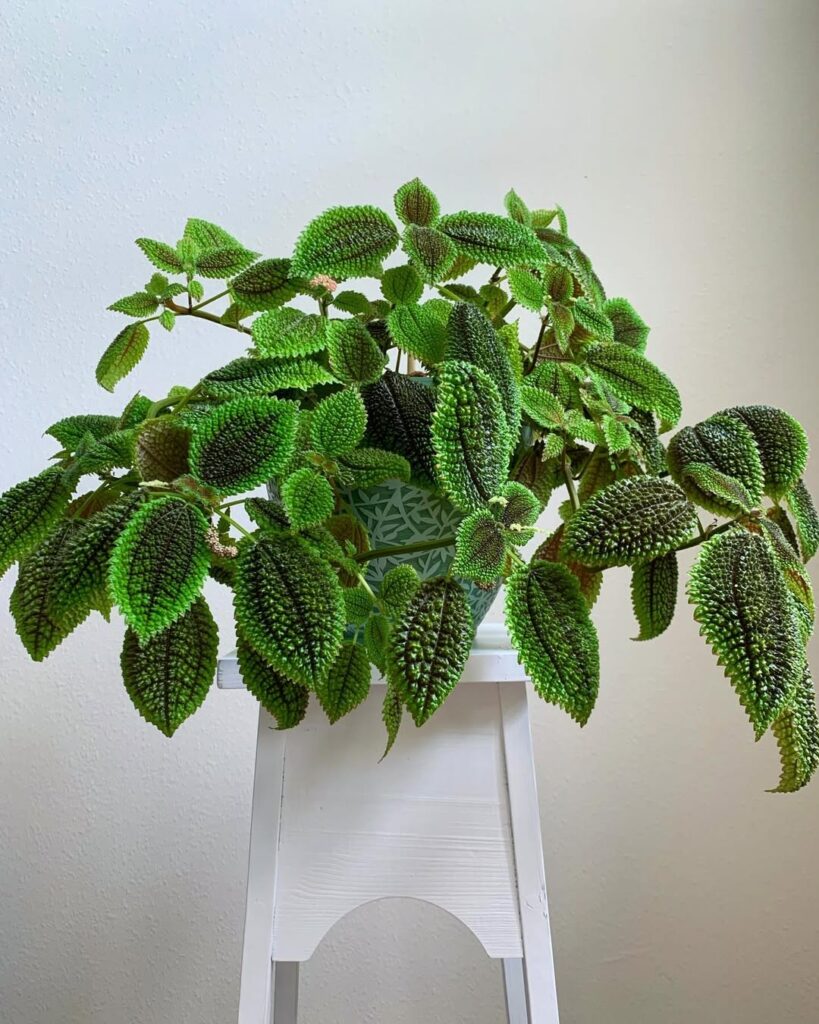
The Moon Valley Pilea (Pilea mollis) showcases distinctive, deeply textured foliage that resembles the cratered surface of the moon. Its quilted, dark green leaves feature deep depressions between raised veins, creating a dramatic topographical effect. The leaves are oval-shaped with serrated edges and grow on reddish-brown stems, forming a compact, bushy plant that typically reaches 12 inches in height.
- Light: Bright, indirect light; protect from direct sunlight
- Water: Keep soil consistently moist but not waterlogged; water when top inch of soil feels dry
- Soil: Well-draining, rich potting mix with good aeration
- Humidity: High humidity (50% or higher)
- Temperature: 65-75°F (18-24°C)
- Fertilizer: Feed monthly with balanced liquid fertilizer during growing season
- Soil pH: 6.0-7.0
11. Rattlesnake Plant
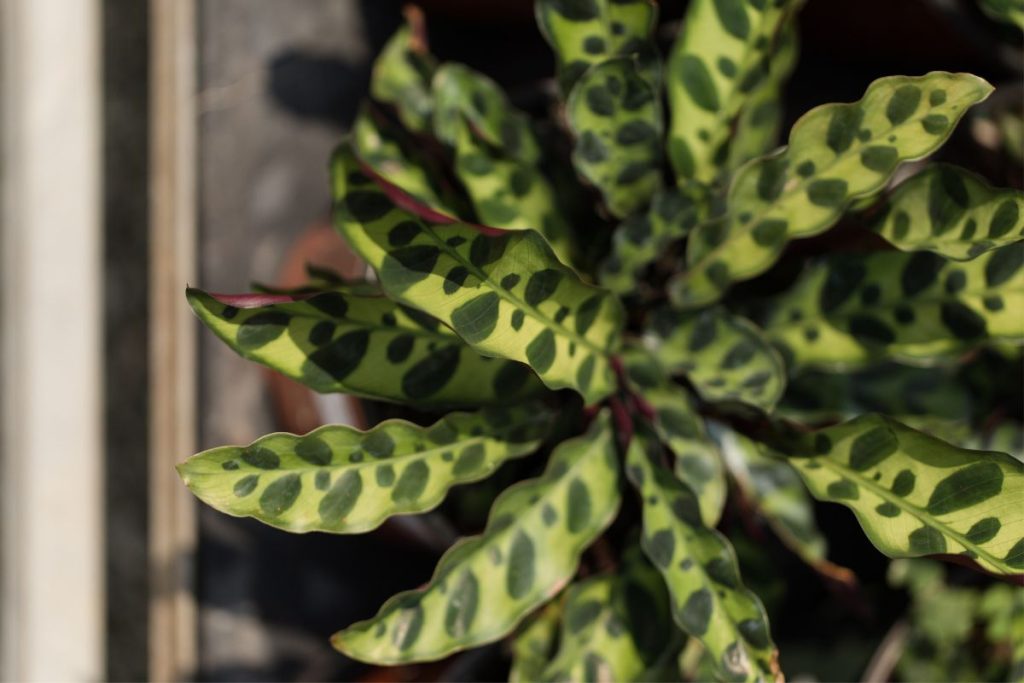
The Rattlesnake Plant (Calathea lancifolia) showcases distinctive wavy leaves with dark green oval patterns that resemble snake scales, giving the plant its common name. These rippled leaves create an eye-catching display as they move throughout the day in response to changing light conditions, a process known as nyctinasty. The undersides of the leaves feature a striking purple hue, adding another layer of visual interest to this tropical beauty.
- Light: Bright indirect light; avoid direct sunlight which can fade patterns
- Water: Keep soil consistently moist but not waterlogged; water when top inch of soil feels dry
- Humidity: High humidity (60% or above); mist regularly or use a humidity tray
- Soil: Well-draining, rich potting mix with peat moss
- Temperature: 65-80°F (18-27°C)
- Fertilizer: Monthly feeding during growing season with balanced liquid fertilizer
- Container: Pot with drainage holes to prevent root rot
12. String of Pearls
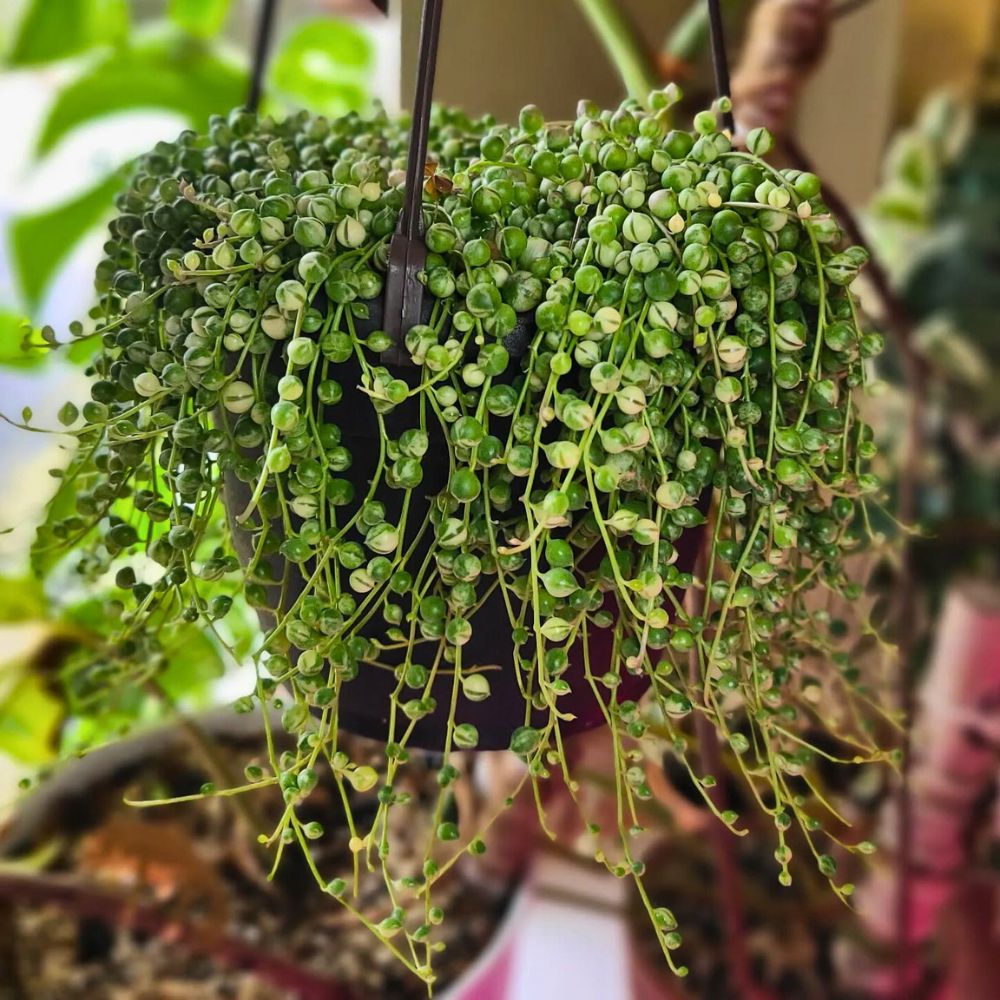
The String of Pearls plant (Senecio rowleyanus) features distinctive bead-like leaves that cascade down from hanging baskets or tall containers in elegant green strands. These spherical leaves store water and give the succulent its unique appearance, with each “pearl” growing along thin, thread-like stems that can reach several feet in length when mature.
- Light: Bright, indirect light; can tolerate some direct morning sun but protect from harsh afternoon rays
- Water: Allow soil to dry between waterings; water sparingly in winter
- Soil: Well-draining cactus or succulent mix
- Humidity: Tolerates average household humidity
- Temperature: 70-80°F (21-27°C); minimum 50°F (10°C)
- Container: Use hanging baskets or elevated pots with drainage holes
- Fertilizer: Light feeding with balanced fertilizer during growing season
- Propagation: Easily propagated through stem cuttings
13. Watermelon Peperomia
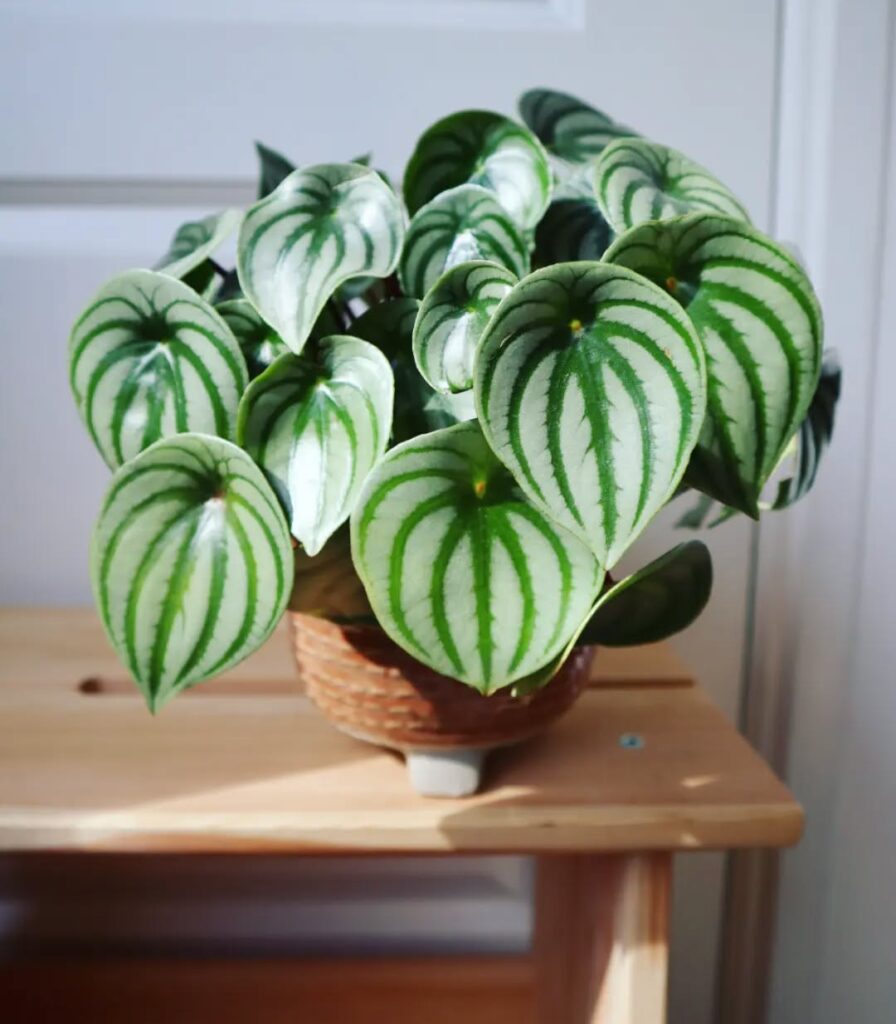
The Watermelon Peperomia (Peperomia argyreia) features distinctive rounded leaves that resemble miniature watermelon rinds, complete with silvery stripes against dark green backgrounds. These compact plants grow in tight clusters, with each leaf attached to a slender stem, creating an attractive, bushy appearance. The leaves’ unique circular shape and watermelon-like pattern make them a striking addition to any indoor plant collection.
- Light: Bright, indirect light; avoid direct sunlight which can fade the distinctive leaf pattern
- Water: Allow top inch of soil to dry between waterings; sensitive to overwatering
- Soil: Well-draining, airy potting mix with perlite or orchid bark
- Humidity: Moderate to high; benefits from occasional misting
- Temperature: 65-80°F (18-27°C)
- Fertilizer: Light feeding with balanced fertilizer during growing season
- Soil pH: 6.0-7.0
14. Peacock Plant
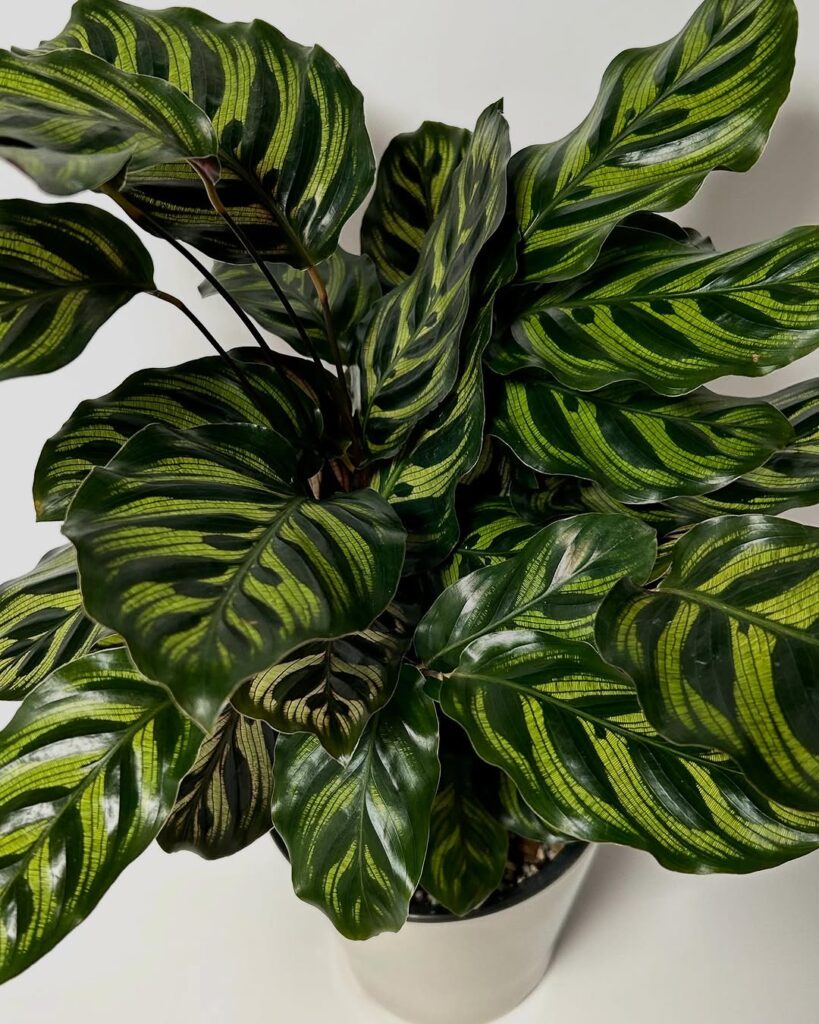
The Peacock Plant (Calathea makoyana) showcases dramatic zebra-striped foliage with alternating light and dark green markings that resemble the pattern of a peacock’s feathers. These distinctive stripes run parallel to the leaf’s central vein, creating an eye-catching display that makes it a prized ornamental houseplant. The undersides of the leaves display a deep purple hue, adding another layer of visual interest when the leaves move throughout the day.
- Light: Bright indirect light; avoid direct sunlight which can fade the stripes
- Water: Keep soil consistently moist but not waterlogged; water when top inch of soil feels dry
- Humidity: High humidity (60-70%); use a humidifier or pebble tray
- Soil: Well-draining, rich potting mix with added peat moss
- Temperature: 65-80°F (18-27°C)
- Fertilizer: Monthly feeding during growing season with balanced liquid fertilizer
- pH: 6.0-6.5 (slightly acidic)
15. Pink Pitcher Plant
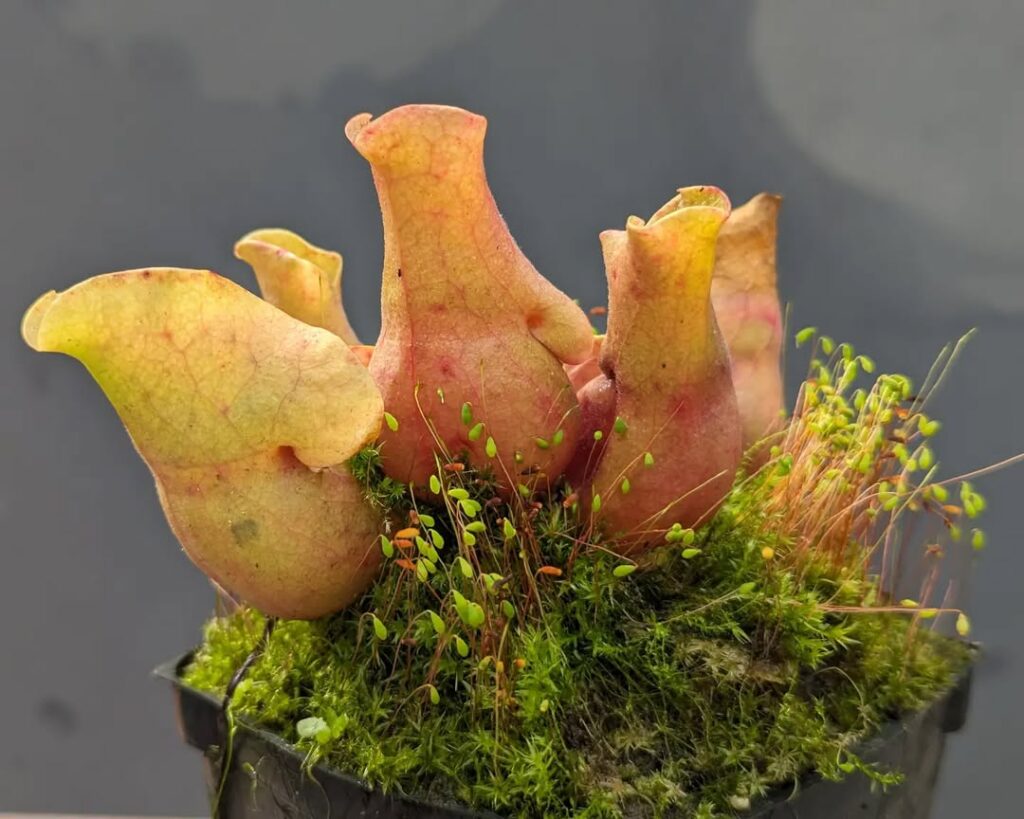
The Pink Pitcher Plant (Sarracenia rosea) features distinctive tubular leaves that form pitcher-shaped traps, typically displaying shades of pink and red with green undertones. These modified leaf structures contain digestive enzymes and attract insects with their sweet nectar, vibrant colors, and downward-facing hairs. Once prey falls into the pitcher, they cannot escape and are slowly digested, providing the plant with essential nutrients it cannot obtain from nutrient-poor soil.
- Light: Full sun to partial sun; minimum 6 hours direct sunlight daily
- Water: Keep soil consistently moist; use distilled, reverse osmosis, or rainwater only
- Soil: Nutrient-poor, acidic mix of sphagnum peat moss and sand
- Humidity: High humidity levels, above 50%
- Temperature: 70-85°F during day, can tolerate brief cold periods
- Fertilizer: None needed; insects provide nutrients
- Growing Medium: Use pots with drainage holes; plastic or glazed ceramic preferred
- Dormancy: Requires winter dormancy period with temperatures between 35-50°F
